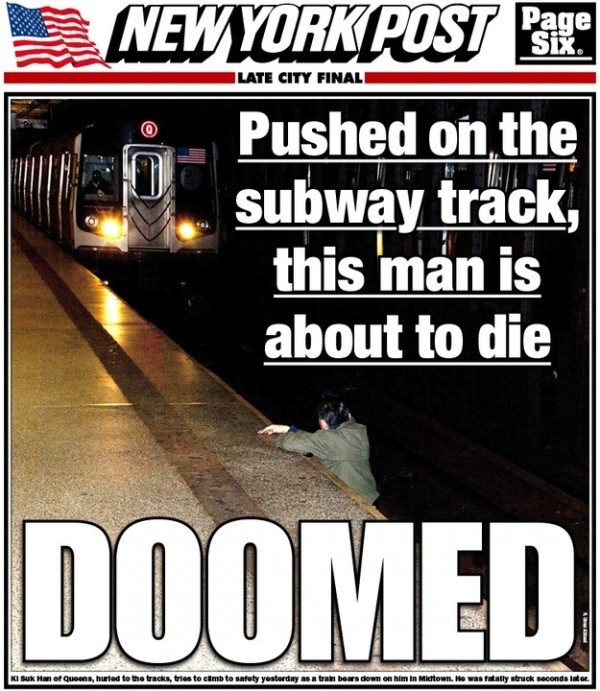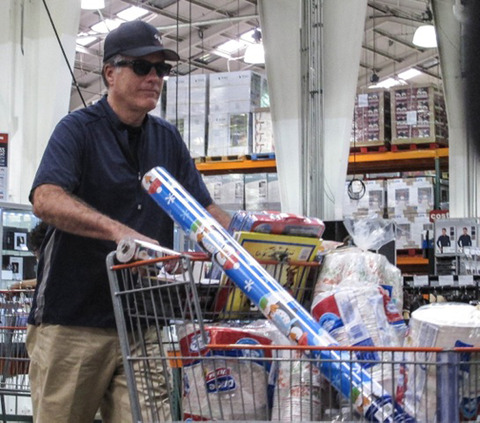Notes
Doom in America: What The NY Post Subway Death Photo Is Really About
In the foreground of the photo, in a setting that is quintessentially New York, we witness a man in a hole so deep, he cannot climb out of it while just beyond him, diagonally to his left, he faces the immediate threat of a fast approaching piece of the city’s machinery.
Is that a description of the NY Post photo of the man killed Monday on the subway tracks? …Or the photo from a week ago, of the encounter between a homeless man and a NYPD officer in Times Square, the officer — in a spontaneous act of kindness — presenting the man with a new pair of boots? The difference, of course, is that one photo was all about fairytales and “feel good,” while the other ended in doom.
Beyond the pitched cries of editorial impropriety, perhaps it’s not at all clear what the subway photo is really saying. When you think about it, for example, what the photo offers is not the story of what happened so much as its consequence. What’s missing in the photo is “the perp,” the push — the event which resulted in the horrible result we’re exposed to above. There is video of arguing, but the infamous photo itself is almost deafeningly solitary, as if Mr. Han got himself in this death trap alone. Thus, if there’s a deeper critique of the photo, it’s that the catalyst and real subject of concern is missing.
Who or what’s missing from this photo, however, is nothing more or less than what was missing in the presidential campaign, and what went missing in the photo coverage of the first day of Hurricane Sandy, and went missing, until too late, in the circumstances of Jared Lee Loughner, the schizophrenic who shot Gabby Giffords, of James Holmes, the psychotic Dark Knight shooter in Aurora, or Jovan Belcher, the seriously depressed pro football player in Kansas City who killed his girlfriend and then himself in front of his coach at the team’s training facility just last week. What was and is missing from all of these “pictures” is any serious focus on America’s down-and-out, the poor, the indigent, the homeless, as well as the (sometimes distinct, but most often overlapping circumstances of the) emotionally sick and the mentally ill.
If we really want to confront the photo taken by Mr. Abbasi in the subway on Monday, what we first have to absorb is that this incident goes beyond a random citizen having the fatal misfortune to mix it up with a crazy and agitated panhandler too close to the edge of the Q train platform. Instead, what needs confronting is the fact that this citizen’s demise (Mr. Han unemployed, reportedly drunk and having just left an argument with his wife) was the consequence of a chance encounter with an(other) American living that doom.
If you happened to read the follow-up to the boots story, by the way, that picture receiving fawning worldwide attention, you discover that the disturbed man in that photo, fearful the boots would be stolen, is on the street barefoot again, while offering up a pretty good rant about his image being used without his permission. Looking back at the Times Square photo and the warm glow that surrounded it, what’s most telling now is how the disturbed homeless vet served as little more than an object, a guilt-assuaging prop in a feel-good fantasy for media consumers everywhere. If yesterday’s photo might be seen as its cousin — one as far from a fantasy as the gap, for Mr. Han, between that platform and survival — the message in the subway photo is that there really are two Americas, and for all of those who have slipped away, help couldn’t come fast enough either.
(photo: R. Umar Abbasi/NY Post)



Reactions
Comments Powered by Disqus